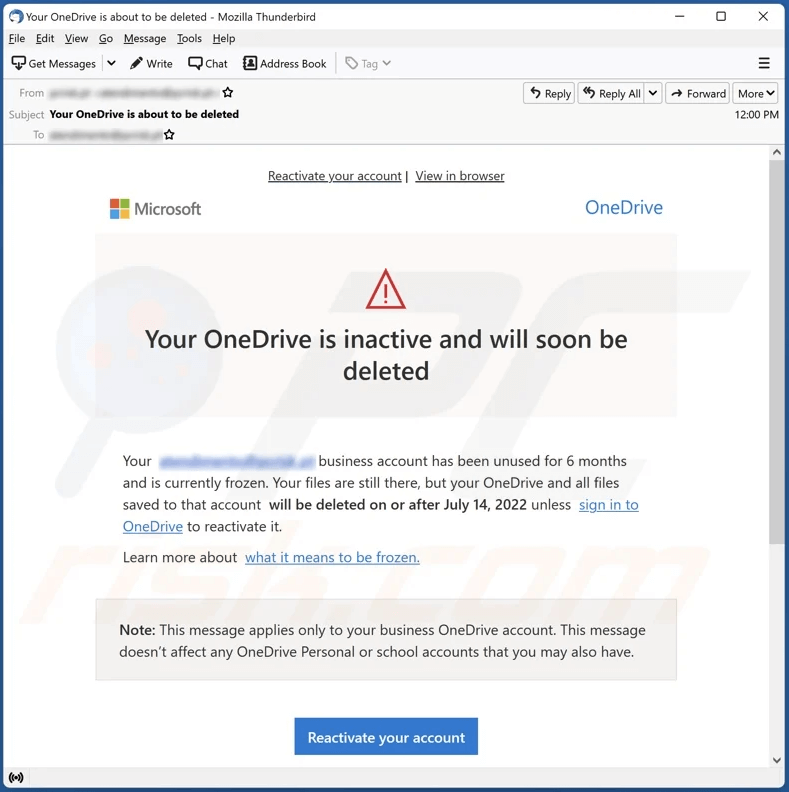Introduction
It can be unpleasant to see the notification "Your OneDrive is inactive and will soon be deleted". It brings to mind lost paperwork, priceless pictures, and a digital wasteland. Let's examine the matter and take a big breath before you give up and go to data purgatory.
This notification can appear for two main reasons: legitimate inactivity from your end, or a sneaky phishing attempt trying to steal your information. This guide will equip you to navigate both scenarios and ensure the safety of your precious cloud storage.
Understanding the "Inactive Account" Message
First, let's understand why Microsoft might send this notification. There are two legitimate reasons:
- Two Years of Inactivity: If you haven't accessed or interacted with your OneDrive account in two years, Microsoft might flag it as inactive. This is a way of reclaiming storage space for active users.
- Exceeding Storage Limits: Free OneDrive accounts come with limited storage. If you surpass this limit and remain inactive for a period, Microsoft might send a warning about potential deletion.
Identifying Phishing Attempts
However, the "inactive account" message can also be a clever phishing attempt. Here's how to identify a potential scam:
- Suspicious Sender Addresses: A legitimate notification will come from an official Microsoft email address. Be wary of emails with generic or misspelled addresses.
- Urgent Tone and Threats: Phishing emails often use scare tactics, urging you to take immediate action or face dire consequences. A legitimate notification will have a clear and informative tone.
- Requesting Personal Information: Microsoft will never ask for your password or other sensitive information through email. If the message prompts you to enter such details, it's a red flag.
Recovering Your OneDrive Account
If you believe the notification is legitimate, here's what to do:
- Verify the Notification's Legitimacy: Check your email address associated with your Microsoft account. If you haven't received any emails from Microsoft regarding inactivity, proceed with caution and assume it might be a phishing attempt.
- Steps to Reactivate Your Account: Visit the official Microsoft website and log in to your OneDrive account using your valid credentials. If your account is truly inactive, Microsoft will guide you through the reactivation process. This might involve verifying your identity or clearing up any outstanding storage issues.
Preventing Future Inactivity
Once you've recovered your account, here's how to avoid future "inactive account" scares:
- Regular Account Use: Access your OneDrive account periodically, even if it's just to browse your files. This demonstrates activity and keeps your account from being flagged as inactive.
- Storage Management Techniques: Clean up your OneDrive and delete unnecessary files to stay within the free storage limit. Alternatively, consider upgrading your storage plan if you require more space.
- Upgrading Storage Plan (if needed): If you consistently exceed the free storage limit, consider upgrading your OneDrive plan to a higher tier offering more storage space. This ensures your files remain safe and accessible without worrying about inactivity warnings.
Alternatives in Case of Permanent Deletion
In the unfortunate scenario where your OneDrive account has been permanently deleted due to prolonged inactivity, here are a few (albeit limited) options:
- Data Recovery Software (Limited Success): Data recovery software can sometimes recover deleted files from your local machine, but this depends on how long they've been gone and whether they were overwritten by other data. Success with this approach is not guaranteed.
- Moving to a Different Cloud Storage Provider: If data recovery proves unsuccessful, consider migrating to a different cloud storage provider. Many options offer free tiers or competitive storage plans.
Remember: Always back up your critical data to multiple locations to avoid relying solely on cloud storage. There is a quick way to back up OneDrive data to multiple cloud storage providers automatically, that is to use MultCloud.

- Offline Backup: Don't rely on the network connection, but use the data traffic for backing up cloud files.
- Direct Backup: Don't go through the local storage, but directly back up files across different clouds online.
- Auto Backup: Back up data regularly without having to manually initiate each backup.
Conclusion
Though concerning, the notification "Your OneDrive is inactive and will soon be deleted" should not be a sign of doom. You may guarantee the security and accessibility of your priceless cloud storage by comprehending the rationale for this message, spotting possible frauds, and managing your account proactively. Remember, regular account activity, smart storage management, and considering alternative backup solutions are key to keeping your data secure for the long haul.
MultCloud Supports Clouds
-
Google Drive
-
Google Workspace
-
OneDrive
-
OneDrive for Business
-
SharePoint
-
Dropbox
-
Dropbox Business
-
MEGA
-
Google Photos
-
iCloud Photos
-
FTP
-
box
-
box for Business
-
pCloud
-
Baidu
-
Flickr
-
HiDrive
-
Yandex
-
NAS
-
WebDAV
-
MediaFire
-
iCloud Drive
-
WEB.DE
-
Evernote
-
Amazon S3
-
Wasabi
-
ownCloud
-
MySQL
-
Egnyte
-
Putio
-
ADrive
-
SugarSync
-
Backblaze
-
CloudMe
-
MyDrive
-
Cubby
